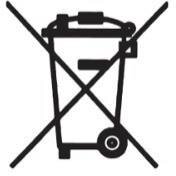ELECTRICAL AND ELECTRONIC EQUIPMENT – INFORMATION FROM MANUFACTURERS FOR COMMERCIAL USERS
The German Electrical and Electronic Equipment Act (ElektroG) contains a large number of requirements for handling electrical and electronic equipment. The most important ones are summarized here.
1. Separate collection of waste equipment
Electrical and electronic equipment that has become waste is referred to as waste equipment. Owners of waste equipment must dispose of it separately from unsorted municipal waste. In particular, waste equipment does not belong in household waste, but in special collection and return systems.
2. Batteries and rechargeable batteries, as well as lamps
Owners of waste equipment must separate old batteries and accumulators that are not enclosed in the waste equipment, as well as lamps that can be removed from the waste equipment without causing damage, from the waste equipment before handing it in at a collection point. This does not apply if waste equipment is sent for preparation for reuse with the involvement of a public waste disposal authority.
3. Options for returning waste equipment
In order to provide options for returning waste equipment, we work with several qualified recycling companies. If a device manufactured by us has become obsolete and you would like to return it, please contact:
https://www.take-e-way.de/leistungen/elektrogesetz-weee-elektrog/b2b-altgeraete-ruecknahme-entsorgung/ and fill out the questionnaire.
4. Privacy Notice
Waste equipment often contains sensitive personal data. This applies in particular to information and telecommunications technology devices such as computers and smartphones. In your own interest, please note that each end user is responsible for deleting the data on the waste equipment to be disposed of.

5. Meaning of the symbol “crossed-out trash can”
The symbol of a crossed-out trash can, which is regularly displayed on electrical and electronic equipment, indicates that the device in question must be collected separately from unsorted municipal waste at the end of its service life.
